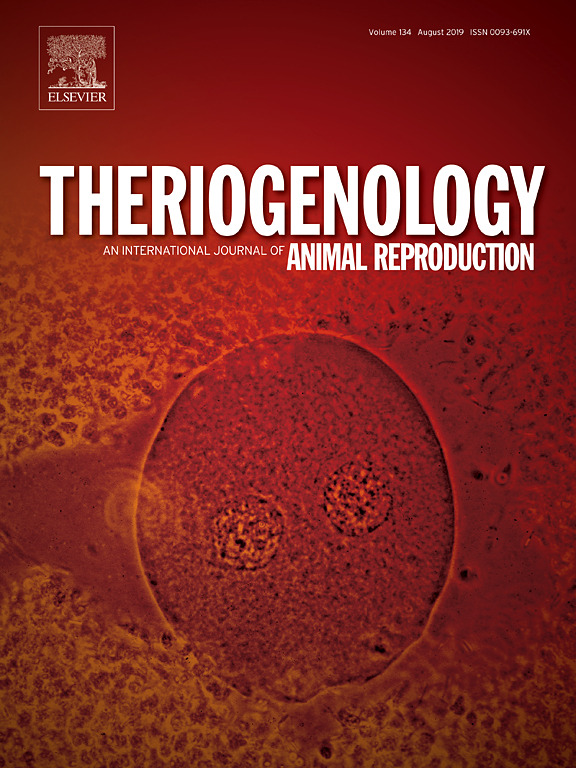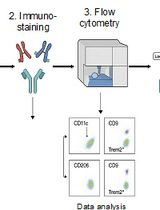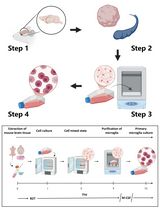- EN - English
- CN - 中文
An Efficient Approach for RNA Extraction from Boar Sperm and Seminal Plasma
一种从公猪精子和精液中提取RNA的高效方法
发布: 2019年07月05日第9卷第13期 DOI: 10.21769/BioProtoc.3284 浏览次数: 7134
评审: Gal HaimovichShweta GargIndranil Malik
Abstract
Despite transcriptional silencing in mature sperm and cytoplasmic expulsion of RNA during the final sperm maturation process, thousands of RNAs have been successfully identified in ejaculated sperm. Although most of RNAs’ function is still unknown, it is suggested that sperm RNAs have a vital biological role in fertilization and post-fertilization events. Nevertheless, the lack of accurate RNA isolation techniques and the resultant good quality sperm RNA has hampered the exploration of sperm RNAs function. Additionally, small non-coding RNAs are found in extracellular fluids including seminal plasma. These small RNAs may participate in cell to cell communication or intracellular and extracellular message transmission. Developing precise protocols to extract RNA from sperm and seminal plasma is critical to elucidate sperm physiology and paternal contributions to fertilization and post-fertilization events. A detailed procedure consisting of semen collection, separation of sperm and seminal plasma, extracting RNA from sperm and seminal plasma, and determining the quantity and quality of RNA for boar semen is presented here. This efficient protocol can be extrapolated to isolate RNAs from sperm and seminal plasma across mammalian species.
Keywords: Semen collection (精液收集)Background
Transcriptionally inactive mature sperm contains a complex population of RNAs including non-coding small RNAs (Ostermeier et al., 2002). These RNAs can participate in fertilization and post-fertilization events including zygotic gene activation. Recently, it was suggested that sperm also can pick up small RNAs on their way during the epididymal transit and these small RNAs can influence the gene regulation in developing embryos for efficient implantation (Kasimanickam et al., 2019b). It is important to study the RNA profiles in immature and mature sperm harvested from various locations such as caput epididymis, cauda epididymis, ejaculated sperm and seminal plasma to know how these RNAs are shuttled between sperm cells and seminal plasma. Better understanding of coding and non-coding RNAs in sperm and seminal plasma by gene expression arrays and microarrays allows investigating the problems associated with infertility. Nevertheless, success of microarray and gene expression analyses is extremely dependent on the quality and quantity of the RNA obtained from sperm and seminal plasma. Therefore, the development of methods that isolate highly purified and intact RNA from sperm and seminal plasma is of utmost importance. Purification of sperm and seminal plasma, RNA extraction from sperm and seminal plasma and evaluation of RNA quality are the critical steps to be considered to achieve these goals. Since sperm and seminal plasma contain a very small amount of RNA, a method consisting capture of RNA by silica membrane and elution using nuclease-free water (column-based approach) is more advantageous to perform rather than a method involving precipitation of RNA. Hence, detailed protocols for semen collection, semen processing to purify sperm and seminal plasma, RNA isolation from sperm and seminal plasma adopting a column-based approach and determining the quantity and quality of RNA for boars are described here.
Materials and Reagents
- Pipette tips (Eppendorf, catalog numbers: 02-717-349, 02-717-351, 02-717-352)
- Disposable homogenizer (Thermo Fisher Scientific, Fisher, catalog number: 12-141-368)
- Polyvinyl gloves (Thermo Fisher Scientific, Fisher Scientific, catalog number: 19-121-834B)
- J-cloth (https://www.amazon.com/J-Cloth-Blue-50s/dp/B00V3UIQ3E)
- Miracloth (Millipore Sigma, Millipore, catalog number: 475855)
- Microscopic slides (Thermo Fisher Scientific, Thermo Scientific, catalog number: 4951PLUS4)
- Microscopic cover glasses (Thermo Fisher Scientific, Thermo Scientific, catalog number: 18X18-1)
- Graduated measuring cylinder
- Falcon tubes, 50 ml (Thermo Fisher Scientific, Corning, catalog number: 14-432-22)
- Microcentrifuge tubes (Thermo Fisher Scientific, Thermo Scientific, catalog number: 3448)
- Square cuvette
- Mature trained boars for semen collection (Landrace boars of 8 to 18 months of age were used in this protocol)
Notes:- Follow institutional guidelines for animal maintenance and use for sample collection.
- Maintain clean semen collection area with appropriate human and animal safety guidelines.
- Beltsville Thawing Solution (Minitube USA, catalog number: 13525)
- Liquid nitrogen (Washington State University Store, WSU, catalog number: 12506)
- RNeasy plus Universal Mini Kit (RNeasy mini spin column, 1.5- and 2.0-ml collection tubes, QIAzol lysis reagent, gDNA eliminator solution, RWT buffer, RPE buffer and RNase free water) (Qiagen Inc., catalog number: 73404)
- Chloroform (VWR International, J.T. Baker, catalog number: 9180-1)
- Ethanol (Washington State University Store, Decon, catalog number: Decon 2701)
- MiRNeasy serum/plasma kit (RNeasy MinElute spin column, 1.5- and 2.0-ml collection tubes, QIAzol lysis reagent, RWT buffer, RPE buffer and RNase free water) (Qiagen Inc., catalog number: 217184)
- MiRNeasy serum/plasma spike-in-controls (Qiagen Inc., Valencia, CA, USA, catalog number: 219610)
- Mild disinfectant solution (Washington State University Store, Decon, catalog number: Decon 57065)
Equipment
- Boar semen collection flask (IMV Technologies USA, IMV, catalog number: 017282)
- Pipettes (Eppendorf, catalog numbers: 2231300034, 2231300037)
- Adjustable built-in semen collection dummy
- Phase-contrast microscope (Minitube, Olympus CX43, heated stage, HT 200, catalog number: 12005/0041)
- Refrigerated centrifuge (Jouan refrigerated centrifuge, model: CR422)
- Microcentrifuge (Eppendorf, model: 5415C)
- Ultra-freezer (-80 °C)
- Spectrophotometer (Thermo Fisher Scientific, model: NanoDrop 1000)
- Benchtop incubator (Unico, model: Unico 30L Incubator #L-CU300)
Procedure
文章信息
版权信息
© 2019 The Authors; exclusive licensee Bio-protocol LLC.
如何引用
Kasimanickam, V. R. and Kasimanickam, R. K. (2019). An Efficient Approach for RNA Extraction from Boar Sperm and Seminal Plasma. Bio-protocol 9(13): e3284. DOI: 10.21769/BioProtoc.3284.
分类
分子生物学 > RNA > RNA 提取
细胞生物学 > 细胞分离和培养 > 细胞分离
您对这篇实验方法有问题吗?
在此处发布您的问题,我们将邀请本文作者来回答。同时,我们会将您的问题发布到Bio-protocol Exchange,以便寻求社区成员的帮助。
Share
Bluesky
X
Copy link












